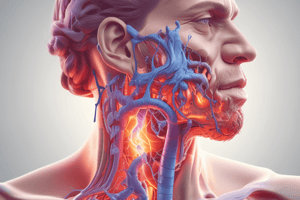Podcast
Questions and Answers
What is the primary function of the nose and nasal passages in the respiratory system?
What is the primary function of the nose and nasal passages in the respiratory system?
- To regulate the rate of breathing
- To warm and humidify incoming air
- To detect changes in air pressure
- To filter out dust particles and small pathogens (correct)
What is the role of the cilia lining the respiratory tract?
What is the role of the cilia lining the respiratory tract?
- To secrete mucus
- To move mucus upwards towards the pharynx (correct)
- To regulate the diaphragm and intercostal muscles
- To detect changes in pH levels
Which part of the brain is responsible for regulating breathing?
Which part of the brain is responsible for regulating breathing?
- Pituitary gland
- Medulla oblongata (correct)
- Hypothalamus
- Cerebellum
What type of receptors detect changes in the body's chemical and physiological needs?
What type of receptors detect changes in the body's chemical and physiological needs?
How does the respiratory system respond to the signals from the medulla oblongata?
How does the respiratory system respond to the signals from the medulla oblongata?
What is the primary purpose of the respiratory system?
What is the primary purpose of the respiratory system?
What is the primary function of the respiratory system?
What is the primary function of the respiratory system?
Where does gas exchange primarily occur in the respiratory system?
Where does gas exchange primarily occur in the respiratory system?
Which component of the respiratory system is responsible for providing oxygen to cells via the circulatory system?
Which component of the respiratory system is responsible for providing oxygen to cells via the circulatory system?
What is the function of the pleura in the respiratory system?
What is the function of the pleura in the respiratory system?
Which part of the respiratory system plays a role in vocalization?
Which part of the respiratory system plays a role in vocalization?
What happens to carbon dioxide in the respiratory system?
What happens to carbon dioxide in the respiratory system?
Study Notes
Respiratory System
The respiratory system is one of the primary systems involved in maintaining homeostasis within the human body. It is responsible for the exchange of gases between the environment and the body, ensuring that oxygen from the air enters the bloodstream while carbon dioxide exits. This process is crucial for our survival and plays a significant role in supporting many physiological processes occurring throughout the body.
Anatomy of the Respiratory System
Major Components
The major components of the human respiratory system include:
- Nose
- Pharynx (throat)
- Larynx (voice box)
- Trachea (windpipe)
- Bronchi
- Terminal bronchioles
- Alveoli
- Pleura
Functions of the Respiratory System
Ventilation
The primary function of the respiratory system is ventilation, which involves the movement of air into and out of the lungs. Air enters through the nose or mouth and passes down the trachea into the lungs, where it provides oxygen to cells via the circulatory system. At the same time, carbon dioxide, a waste product of cellular metabolism, diffuses out of the bloodstream into the alveoli and leaves the body through exhalation.
Gas Exchange
The respiratory system facilitates gas exchange between the lungs and the environment. Oxygen from the air is absorbed by the bloodstream, primarily in the alveolar capillaries, while carbon dioxide from the bloodstream diffuses into the alveoli to be exhaled out of the lungs.
Protection Against Particles and Germs
The nose and nasal passages serve as filters to remove dust particles and small pathogens from the incoming air stream. The cilia lining the respiratory tract also help to prevent infection by moving mucus upwards towards the pharynx, where it can be swallowed or expectorated.
Regulation of Breathing
Breathing is regulated by the autonomic nervous system, specifically the medulla oblongata in the brainstem. Chemoreceptors located in the brain detect changes in pH levels (acid-base balance), tissue oxygenation, and carbon dioxide tension in the blood. In response to these stimuli, the medulla sends signals to the diaphragm and intercostal muscles to increase or decrease respiration rate accordingly.
In summary, the respiratory system performs essential functions in maintaining life-sustaining processes within the human body. It ensures adequate oxygen supply and removal of carbon dioxide waste products, protects against external threats, and regulates its own functions autonomously based on chemical and physiological needs.
Studying That Suits You
Use AI to generate personalized quizzes and flashcards to suit your learning preferences.
Description
Explore the anatomy and functions of the respiratory system, including major components like nose, trachea, and alveoli. Learn about ventilation, gas exchange, and the system's role in protecting against particles and germs. Understand how breathing is regulated by the autonomic nervous system to maintain homeostasis.





